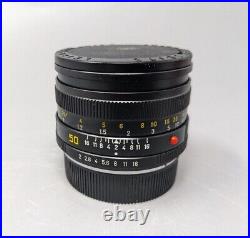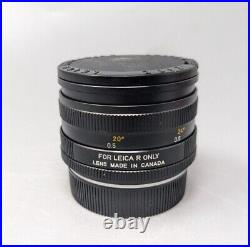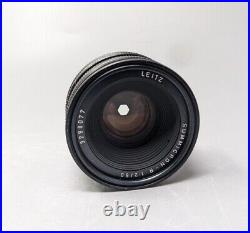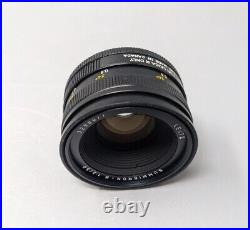Pristine Leica R 50mm f2 Summicron Lens with box SN 3298077 from 1984








This Leica R 50mm f2 Summicron Lens is a gem for any photography enthusiast. With its manual focus type and maximum aperture of f/2, it produces stunning photos with great depth of field. It is a standard lens that is compatible with Leica R mount and has a focal length of 50mm, the lens is in pristine condition and comes with its original box.
It is a valuable addition to any camera and photo collection. Capture your memories with this high-quality lens and experience the wonders of Leica's craftsmanship.The SN: is 3298077 giving it a manufacture date from 1984. More on the Leica R 50mm f2 Summicron Lens. When in 1963, with a guilty delay over the competition, the pre-series production chain of Leicaflex cameras was started, it had already been defined that the standard optics envisaged for the new range of devices called to the difficult test would be a Summicron 50mm f/ 2, a choice made in the wake of the great global success achieved by the equivalent model for Leica M and justified by the right compromise between already high brightness and the possibility of optimal aberration correction guaranteed by this configuration. The father of this strategically very important lens was Walter Mandler, who, having to face the additional calculation problems inherent in the retrofocus scheme, adopted a Double Gauss type configuration with 6 lenses in 5 groups with 12 refracting surfaces, a glued doublet placed behind the diaphragm and air lenses between the front elements, all details that allowed him to optimize the calculation of aberrations and create a true masterpiece.
At the time, the new concept of an objective focused more on contrast than on pure resolution was becoming established, starting from the principle that the available emulsions had a maximum resolution corresponding to a "limit" spatial frequency, beyond which it no longer made sense to push the lens any further. Analytical power of the lens: vice versa, it was advantageous for the subjective impression of sharpness to concentrate the "strength" of the confusion circles relating to the spatial frequencies corresponding to the scale of reproduction of the significant details of the image, producing lenses with perhaps lower resolution (limiting values?? to the range used by the films) but characterized by a very vigorous and contrasted reproduction of low and medium spatial frequencies. The Summicron-R 50mm f/2 presented with the original Leicaflex was one of the most striking examples of this new course, and the effectiveness of these choices was immediately confirmed by the practical results: the Summicron-R presented such a reproduction at f/2 clear and contrasted to constitute a clear step forward compared to previous Leitz lenses of the same brightness: the project had in fact been optimized to obtain very high performance at the widest apertures, creating a bright lens that could truly be exploited to 100% of its potential without annoying compromises qualitative.Mandler himself, in 1976, will put his masterpiece to work creating a second version of Summicron-R, characterized by a double Gauss scheme with 6 lenses in 4 groups and 2 collated doublets, which will remain in the breach until the production parabola of the R system and the discontinuation of the R9 model at the end of the past decade; This very objective is the subject of these brief notes, aimed at understanding which guiding principles inspired the new project and what the practical repercussions were on the reproduction performance compared to the glorious version it replaced.
